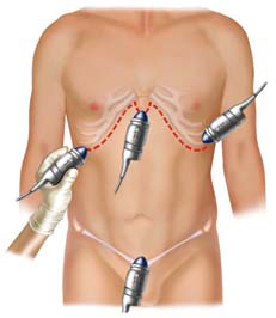Pitfalls
As with any ultrasound study, it is very important to be cognizant of the limitations and pitfalls of the examination. Below are common pitfalls to be aware of during a FAST exam.
1. Bowel gas or other air impedance to a proper FAST exam
a. Partial exam may be possible
b. Resort to alternative study
2. Negative exam does not mean injury is absent
a. 500cc of fluid may be necessary to provide a positive exam
b. Repeat FAST as necessary
3. Even severe injuries may not cause free fluid extravasation
a. FAST may not reveal the following:
i. Contained solid organ injuries
ii. Hollow viscus injuries
iii. Mesenteric vascular injuries
iv. Diaphragmatic injury
4. Antecedent medical condition leading to peritoneal or pericardial free fluid may be mistaken for traumatic injury
a. Ascites
b. Preexisting pericardial or pleural effusions

5. FAST may not be a reliable method of evaluating solid organ injuries
6. FAST does not identify retroperitoneal hemorrhage
7. A negative FAST does not exclude intra-abdominal injury after penetrating trauma
8. Clotted blood may have similar sonographic qualities to soft tissue and may therefore be overlooked.
9. Perinephric fat may be mistaken for hemoperitoneum
10. Fluid in bowel or stomach may be mistaken for hemoperitoneum
11. Small hemothoraces may be missed in a supine patient
a. If possible, an upright scan may be helpful
12. If pericardial fluid is suggested, consider the following conditions/anatomy that may produce a false negative interpretation:
a. Epicardial fat pads
b. Pericardial cysts
c. Descending aorta
13. Significant abdominal or thoracic adhesions may prevent or slow free fluid from collecting in normal locations – subsequent repeat exams are important
14. Posterior acoustic enhancement caused by the bladder may cause free fluid in the pelvis to be overlooked
Onto FAST Technique
|
|
|